
James Gillray
Encyclopedia
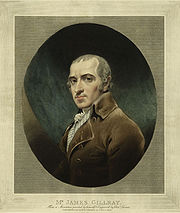
United Kingdom
The United Kingdom of Great Britain and Northern IrelandIn the United Kingdom and Dependencies, other languages have been officially recognised as legitimate autochthonous languages under the European Charter for Regional or Minority Languages...
caricaturist and printmaker famous for his etched
Etching
Etching is the process of using strong acid or mordant to cut into the unprotected parts of a metal surface to create a design in intaglio in the metal...
political and social satires, mainly published between 1792 and 1810.
Early life
He was born in ChelseaChelsea, London
Chelsea is an area of West London, England, bounded to the south by the River Thames, where its frontage runs from Chelsea Bridge along the Chelsea Embankment, Cheyne Walk, Lots Road and Chelsea Harbour. Its eastern boundary was once defined by the River Westbourne, which is now in a pipe above...
. His father, a native of Lanark
Lanark
Lanark is a small town in the central belt of Scotland. Its population of 8,253 makes it the 100th largest settlement in Scotland. The name is believed to come from the Cumbric Lanerc meaning "clear space, glade"....
, had served as a soldier, losing an arm at the Battle of Fontenoy
Battle of Fontenoy
The Battle of Fontenoy, 11 May 1745, was a major engagement of the War of the Austrian Succession, fought between the forces of the Pragmatic Allies – comprising mainly Dutch, British, and Hanoverian troops under the nominal command of the Duke of Cumberland – and a French army under Maurice de...
, and was admitted, first as an inmate, and afterwards as an outdoor pensioner, at Chelsea Hospital. Gillray commenced life by learning letter-engraving, at which he soon became adept. This employment, however, proved irksome to James, so he wandered about for a time with a company of strolling players. After a very checkered experience he returned to London and was admitted as a student in the Royal Academy
Royal Academy
The Royal Academy of Arts is an art institution based in Burlington House on Piccadilly, London. The Royal Academy of Arts has a unique position in being an independent, privately funded institution led by eminent artists and architects whose purpose is to promote the creation, enjoyment and...
, supporting himself by engraving, and probably issuing a considerable number of caricatures under fictitious names. His caricatures are almost all in etching
Etching
Etching is the process of using strong acid or mordant to cut into the unprotected parts of a metal surface to create a design in intaglio in the metal...
, some also with aquatint
Aquatint
Aquatint is an intaglio printmaking technique, a variant of etching.Intaglio printmaking makes marks on the matrix that are capable of holding ink. The inked plate is passed through a printing press together with a sheet of paper, resulting in a transfer of the ink to the paper...
, and a few using stipple technique. None can correctly be described as engraving
Engraving
Engraving is the practice of incising a design on to a hard, usually flat surface, by cutting grooves into it. The result may be a decorated object in itself, as when silver, gold, steel, or glass are engraved, or may provide an intaglio printing plate, of copper or another metal, for printing...
s, although this term is often loosely used to describe them. Hogarth
William Hogarth
William Hogarth was an English painter, printmaker, pictorial satirist, social critic and editorial cartoonist who has been credited with pioneering western sequential art. His work ranged from realistic portraiture to comic strip-like series of pictures called "modern moral subjects"...
's works were the delight and study of his early years. Paddy on Horseback, which appeared in 1779, is the first caricature which is certainly his. Two caricatures on Admiral Rodney's naval victory at the Battle of the Saintes
Battle of the Saintes
The Battle of the Saintes took place over 4 days, 9 April 1782 – 12 April 1782, during the American War of Independence, and was a victory of a British fleet under Admiral Sir George Rodney over a French fleet under the Comte de Grasse forcing the French and Spanish to abandon a planned...
, issued in 1782, were among the first of the memorable series of his political sketches.
Adult life
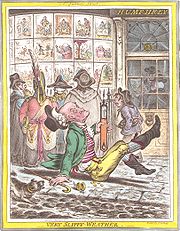

Strand, London
Strand is a street in the City of Westminster, London, England. The street is just over three-quarters of a mile long. It currently starts at Trafalgar Square and runs east to join Fleet Street at Temple Bar, which marks the boundary of the City of London at this point, though its historical length...
, then in New Bond Street, then in Old Bond Street, and finally in St James's Street—is inextricably associated with that of the caricaturist himself. Gillray lived with Miss (often called Mrs) Humphrey during the entire period of his fame. It is believed that he several times thought of marrying her, and that on one occasion the pair were on their way to the church, when Gillray said: "This is a foolish affair, methinks, Miss Humphrey. We live very comfortably together; we had better let well alone." There is no evidence, however, to support the stories which scandalmongers invented about their relations. One of Gillray's prints, "Twopenny Whist," is a depiction of four individuals playing cards, and the character shown second from the left, an ageing lady with eyeglasses and a bonnet, is widely believed to be an accurate depiction of Miss Humphrey.
Gillray's plates were exposed in Humphrey's shop window, where eager crowds examined them. One of his later prints, Very Slippy-Weather, shows Miss Humphrey's shop in St. James's Street in the background. In the shop window a number of Gillray's previously published prints, such as Tiddy-Doll the Great French Gingerbread Maker, Drawing Out a New Batch of Kings; His Man, Talley Mixing up the Dough, a satire on Napoleon's king-making proclivities, are shown in the shop window. His last work, from a design by Bunbury
Henry William Bunbury
Henry William Bunbury was an English caricaturist.The second son of Sir William Bunbury, 5th Baronet , of Mildenhall, Suffolk, he came of an old Norman family...
, is entitled Interior of a Barber's Shop in Assize Time, and is dated 1811. While he was engaged on it he became mad, although he had occasional intervals of sanity, which he employed on his last work. The approach of madness may have been hastened by his intemperate habits. Gillray died on 1 June 1815, and was buried in St James's churchyard, Piccadilly
Piccadilly
Piccadilly is a major street in central London, running from Hyde Park Corner in the west to Piccadilly Circus in the east. It is completely within the city of Westminster. The street is part of the A4 road, London's second most important western artery. St...
.
The art of caricature
A number of his most trenchant satires are directed against George IIIGeorge III of the United Kingdom
George III was King of Great Britain and King of Ireland from 25 October 1760 until the union of these two countries on 1 January 1801, after which he was King of the United Kingdom of Great Britain and Ireland until his death...
, who, after examining some of Gillray's sketches, said "I don't understand these caricatures." Gillray revenged himself for this utterance by his splendid caricature entitled, A Connoisseur Examining a Cooper, which he is doing by means of a candle on a "save-all"; so that the sketch satirises at once the king's pretensions to knowledge of art and his miserly habits.
During the French Revolution
French Revolution
The French Revolution , sometimes distinguished as the 'Great French Revolution' , was a period of radical social and political upheaval in France and Europe. The absolute monarchy that had ruled France for centuries collapsed in three years...
, Gillray took a conservative stance; and he issued caricature after caricature ridiculing the French and Napoleon (usually using Jacobin
Jacobin (politics)
A Jacobin , in the context of the French Revolution, was a member of the Jacobin Club, a revolutionary far-left political movement. The Jacobin Club was the most famous political club of the French Revolution. So called from the Dominican convent where they originally met, in the Rue St. Jacques ,...
), and glorifying John Bull
John Bull
John Bull is a national personification of Britain in general and England in particular, especially in political cartoons and similar graphic works. He is usually depicted as a stout, middle-aged man, often wearing a Union Flag waistcoat.-Origin:...
. A number of these were published in the Anti-Jacobin Review
Anti-Jacobin Review
The Anti-Jacobin Review and Magazine, or, Monthly Political and Literary Censor , a conservative British political periodical, was founded by John Gifford [pseud. of John Richards Green] after the demise of William Gifford's The Anti-Jacobin, or, Weekly Examiner...
. He is not, however, to be thought of as a keen political adherent of either the Whig
British Whig Party
The Whigs were a party in the Parliament of England, Parliament of Great Britain, and Parliament of the United Kingdom, who contested power with the rival Tories from the 1680s to the 1850s. The Whigs' origin lay in constitutional monarchism and opposition to absolute rule...
or the Tory
Tory
Toryism is a traditionalist and conservative political philosophy which grew out of the Cavalier faction in the Wars of the Three Kingdoms. It is a prominent ideology in the politics of the United Kingdom, but also features in parts of The Commonwealth, particularly in Canada...
party; his caricatures satirized members of all sides of the political spectrum.
The times in which Gillray lived were peculiarly favourable to the growth of a great school of caricature. Party warfare was carried on with great vigour and not a little bitterness; and personalities were freely indulged in on both sides. Gillray's incomparable wit and humour, knowledge of life, fertility of resource, keen sense of the ludicrous, and beauty of execution, at once gave him the first place among caricaturists. He is honourably distinguished in the history of caricature by the fact that his sketches are real works of art. The ideas embodied in some of them are sublime and poetically magnificent in their intensity of meaning, while the forthrightness—which some have called coarseness—which others display is characteristic of the general freedom of treatment common in all intellectual departments in the 18th century. The historical value of Gillray's work has been recognized by many discerning students of history. As has been well remarked: "Lord Stanhope
Charles Stanhope, 3rd Earl Stanhope
Charles Stanhope, 3rd Earl Stanhope aka Charles Mahon, 3rd Earl Stanhope FRS was a British statesman and scientist. He was the father of the great traveller and Arabist Lady Hester Stanhope and brother-in-law of William Pitt the Younger. He is sometimes confused with an exact contemporary of his,...
has turned Gillray to account as a veracious reporter of speeches, as well as a suggestive illustrator of events."
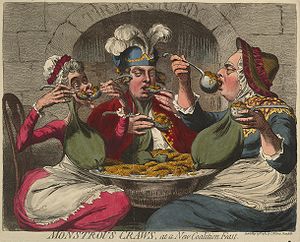
Encyclopædia Britannica Eleventh Edition
The Encyclopædia Britannica Eleventh Edition is a 29-volume reference work, an edition of the Encyclopædia Britannica. It was developed during the encyclopaedia's transition from a British to an American publication. Some of its articles were written by the best-known scholars of the time...
, "Gillray is as invaluable to the student of English manners as to the political student, attacking the social follies of the time with scathing satire; and nothing escapes his notice, not even a trifling change of fashion in dress. The great tact Gillray displays in hitting on the ludicrous side of any subject is only equalled by the exquisite finish of his sketches—the finest of which reach an epic grandeur and Miltonic
John Milton
John Milton was an English poet, polemicist, a scholarly man of letters, and a civil servant for the Commonwealth of England under Oliver Cromwell...
sublimity of conception."
Gillray's caricatures are generally divided into two classes, the political series and the social, though it is important not to attribute to the term "series" any concept of continuity or completeness. The political caricatures comprise an important and invaluable component of the history extant of the latter part of the reign of George III. They were circulated not only in Britain
Kingdom of Great Britain
The former Kingdom of Great Britain, sometimes described as the 'United Kingdom of Great Britain', That the Two Kingdoms of Scotland and England, shall upon the 1st May next ensuing the date hereof, and forever after, be United into One Kingdom by the Name of GREAT BRITAIN. was a sovereign...
but also throughout Europe, and exerted a powerful influence both in Britain and abroad. In the political prints, George III
George III of the United Kingdom
George III was King of Great Britain and King of Ireland from 25 October 1760 until the union of these two countries on 1 January 1801, after which he was King of the United Kingdom of Great Britain and Ireland until his death...
, George's wife Queen Charlotte
Charlotte of Mecklenburg-Strelitz
Charlotte of Mecklenburg-Strelitz was the Queen consort of the United Kingdom as the wife of King George III...
, the Prince of Wales
George IV of the United Kingdom
George IV was the King of the United Kingdom of Great Britain and Ireland and also of Hanover from the death of his father, George III, on 29 January 1820 until his own death ten years later...
(later Prince Regent
Prince Regent
A prince regent is a prince who rules a monarchy as regent instead of a monarch, e.g., due to the Sovereign's incapacity or absence ....
, then King George IV
George IV of the United Kingdom
George IV was the King of the United Kingdom of Great Britain and Ireland and also of Hanover from the death of his father, George III, on 29 January 1820 until his own death ten years later...
), Fox
Charles James Fox
Charles James Fox PC , styled The Honourable from 1762, was a prominent British Whig statesman whose parliamentary career spanned thirty-eight years of the late 18th and early 19th centuries and who was particularly noted for being the arch-rival of William Pitt the Younger...
, Pitt the Younger
William Pitt the Younger
William Pitt the Younger was a British politician of the late 18th and early 19th centuries. He became the youngest Prime Minister in 1783 at the age of 24 . He left office in 1801, but was Prime Minister again from 1804 until his death in 1806...
, Burke
Edmund Burke
Edmund Burke PC was an Irish statesman, author, orator, political theorist and philosopher who, after moving to England, served for many years in the House of Commons of Great Britain as a member of the Whig party....
and Napoleon Bonaparte are the most prominent figures. In 1788 appeared two fine caricatures by Gillray. Blood on Thunder fording the Red Sea represents Lord Thurlow
Edward Thurlow, 1st Baron Thurlow
Edward Thurlow, 1st Baron Thurlow PC, KC was a British lawyer and Tory politician. He served as Lord Chancellor of Great Britain for fourteen years and under four Prime Ministers.- Early life:...
carrying Warren Hastings
Warren Hastings
Warren Hastings PC was the first Governor-General of India, from 1773 to 1785. He was famously accused of corruption in an impeachment in 1787, but was acquitted in 1795. He was made a Privy Councillor in 1814.-Early life:...
through a sea of gore: Hastings looks very comfortable, and is carrying two large bags of money. Market-Day pictures the ministerialists of the time as cattle for sale.
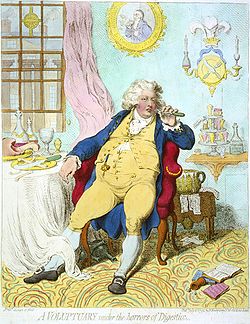
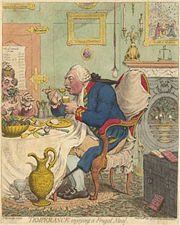

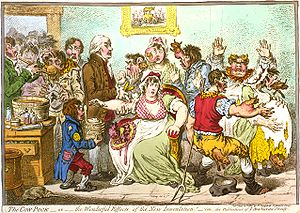


George III of the United Kingdom
George III was King of Great Britain and King of Ireland from 25 October 1760 until the union of these two countries on 1 January 1801, after which he was King of the United Kingdom of Great Britain and Ireland until his death...
are: Farmer George and his Wife, two companion plates, in one of which the king is toasting muffins for breakfast, and in the other the queen is frying sprats; The Anti-Saccharites, where the royal pair propose to dispense with sugar, to the great horror of the family; A Connoisseur Examining a Cooper; the paired plates A Voluptuary under the Horrors of Digestion and Temperance enjoying a Frugal Meal, satirising the excesses of the Prince Regent
Prince Regent
A prince regent is a prince who rules a monarchy as regent instead of a monarch, e.g., due to the Sovereign's incapacity or absence ....
(later George IV of the United Kingdom
George IV of the United Kingdom
George IV was the King of the United Kingdom of Great Britain and Ireland and also of Hanover from the death of his father, George III, on 29 January 1820 until his own death ten years later...
) and the miserliness of his father, George III of the United Kingdom
George III of the United Kingdom
George III was King of Great Britain and King of Ireland from 25 October 1760 until the union of these two countries on 1 January 1801, after which he was King of the United Kingdom of Great Britain and Ireland until his death...
respectively; Royal Affability; A Lesson in Apple Dumplings; and The Pigs Possessed.
Other political caricatures include: Britannia between Scylla and Charybdis, a picture in which Pitt, so often Gillray's butt, figures in a favourable light; The Bridal Night; The Apotheosis of Hoche, which concentrates the excesses of the French Revolution in one view; The Nursery with Britannia reposing in Peace; The First Kiss these Ten Years (1803), another satire on the peace, which is said to have greatly amused Napoleon; The Hand-Writing upon the Wall; The Confederated Coalition, a swipe at the coalition which superseded the Addington ministry; Uncorking Old Sherry; The Plumb-Pudding in Danger (probably the best known political print ever published); Making Decent; Comforts of a Bed of Roses; View of the Hustings in Covent Garden; Phaethon Alarmed; and Pandora opening her Box.
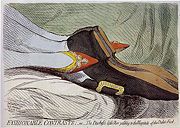
The miscellaneous series of caricatures, although they have scarcely the historical importance of the political series, are more readily intelligible, and are even more amusing. Among the finest are: Shakespeare Sacrificed; Flemish Characters (two plates); Two-Penny Whist (which features an image of Hannah Humphrey); Oh that this too solid flesh would melt; Sandwich-Carrots; The Gout; Comfort to the Corns; Begone Dull Care; The Cow-Pock, which gives humorous expression to the popular dread of vaccination
Vaccination
Vaccination is the administration of antigenic material to stimulate the immune system of an individual to develop adaptive immunity to a disease. Vaccines can prevent or ameliorate the effects of infection by many pathogens...
; Dilletanti Theatricals; and Harmony before Matrimony and Matrimonial Harmonics—two exceedingly good sketches in violent contrast to each other.
Famous editions
A selection of Gillray's works appeared in James Gillray The Caricatures printed between 1818 and the mid 1820s published by John Miller, Bridge Street and W. Blackwood, Edinburgh. Nine parts were released, the next edition was Thomas McLean's, which was published with a key, in 1830. A somewhat bitter attack, not only on Gillray's character, but even on his genius, appeared in the AthenaeumAthenaeum (magazine)
The Athenaeum was a literary magazine published in London from 1828 to 1921. It had a reputation for publishing the very best writers of the age....
for 1 October 1831, which was successfully refuted by John Landseer in the Athenaeum a fortnight later.
In 1851 Henry George Bohn
Henry George Bohn
Henry George Bohn was a British publisher. He is principally remembered for the Libraries which he inaugurated: these were begun in 1846 and comprised editions of standard works and translations, dealing with history, science, classics, theology and archaeology.-Biography:Bohn was born in London...
put out an edition, from the original plates in a handsome elephant folio, the coarser sketches—commonly known as the "Suppressed Plates"—being published in a separate volume. For this edition Thomas Wright and RH Evans wrote a valuable commentary, which is a good history of the times embraced by the caricatures. Unfortunately, many copies of the Bohn Edition are broken up into individual sheets and passed off as originals to unsuspecting buyers (see Collecting below). Although the two volumes of the Bohn Edition are often represented as being a complete collection of Gillray's works, this is not the case: for example, Doublûres of Characters is not included in either volume. This is most likely because this print was not published by Hannah Humphrey, but by John Wright for the Anti-Jacobin Review and Magazine.
The next edition, entitled The Works of James Gillray, the Caricaturist: with the Story of his Life and Times (Chatto & Windus, 1874), was the work of Thomas Wright, and, by its popular exposition and narrative, introduced Gillray to a very large circle formerly ignorant of him. This edition, which is complete in one volume, contains two portraits of Gillray, and upwards of 400 illustrations. Mr JJ Cartwright, in a letter to the Academy (28 Feb. 1874), drew attention to the existence of a manuscript volume, in the British Museum
British Museum
The British Museum is a museum of human history and culture in London. Its collections, which number more than seven million objects, are amongst the largest and most comprehensive in the world and originate from all continents, illustrating and documenting the story of human culture from its...
, containing letters to and from Gillray, and other illustrative documents. The extracts he gave were used in a valuable article in the Quarterly Review for April 1874. See also the Academy for 21 February and 16 May 1874.
Collecting
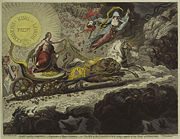
This dramatic increase in prices has also led to unscrupulous sellers attempting to pass off prints from the Bohn Edition as originals, and it can be difficult for those unfamiliar with these practices to tell the difference between a restrike (commonly called "a Bohn") and an original. The key indicators of a print coming from the Bohn Edition are (i) the presence of a number in the top, right-hand corner of the print (the number is most commonly in the image itself, but may be outside in the margin); (ii) the fact that the Bohn edition was issued without colouring; and (iii) the fact that the strikes for the main published volumes of the Bohn Edition were printed on both sides of the paper (the Bohn Edition of the so-called "Suppressed Plates" was, like the originals, printed on one side of the paper only). However, the fact that a print is single-sided does not mean that it is not a Bohn restrike: there are in existence many Bohns (for example, Light expelling Darkness) that bear a number, but which are printed on one side of the paper only. These single-sided numbered strikes are almost always printed on much higher quality paper than was used for the bound volumes, and the quality of the printing is usually much superior too, with more care having been taken to ensure a crisp impression. These impressions are believed to have been struck by Henry Bohn with a view to colouring them, and then selling them as high-quality single prints, in much the same way as the prints published in Gillray's lifetime. There are many example of such single-sided restrikes, both coloured and uncoloured. Since prices for Bohns are usually between one-tenth and one-twentieth of those for originals, unscrupulous sellers will go to great lengths to disguise the fact that a print is a Bohn. Some common methods include: (i) tortuously worded descriptions, which attempt to avoid disclosure of the fact the print is a restrike (although some sellers will just plain lie); (ii) if the number is outside the image, trimming the print to the very edges of the image; (iii) if the number is inside the image, carefully abrading the surface to obliterate the number; (iv) cutting strips of the image to remove the number; (v) laying the print to paper or framing it such that it is difficult to determine whether there is printing on the reverse; and (vi) adding colour.
Also recently the prices of the John Miller editions are rapidly increasing in value because they are affordable for collectors and is seen as a solid investment. They are seen as good alternative to the desirable originals of Mrs. Humphrey's print shop.
Later life and death
Gillray's eyesight began to fail in 1806. He began wearing spectacles but they were unsatisfactory. Unable to work to his previous high standards, James Gillray became depressed and started drinking heavily. He produced his last print in September 1809. As a result of his heavy drinking Gillray suffered from goutGout
Gout is a medical condition usually characterized by recurrent attacks of acute inflammatory arthritis—a red, tender, hot, swollen joint. The metatarsal-phalangeal joint at the base of the big toe is the most commonly affected . However, it may also present as tophi, kidney stones, or urate...
throughout his later life.
In July 1811 Gillray attempted to kill himself by throwing himself out of an attic window above Humphrey's shop in St James's Street. Gillray lapsed into insanity and was looked after by Hannah Humphrey until his death on 1 June 1815.
James Gillray was buried in the courtyard of St James's Church, in Piccadilly
Piccadilly
Piccadilly is a major street in central London, running from Hyde Park Corner in the west to Piccadilly Circus in the east. It is completely within the city of Westminster. The street is part of the A4 road, London's second most important western artery. St...
, London
London
London is the capital city of :England and the :United Kingdom, the largest metropolitan area in the United Kingdom, and the largest urban zone in the European Union by most measures. Located on the River Thames, London has been a major settlement for two millennia, its history going back to its...
.
Influence
Gillray is still revered as one of the most influential political caricaturists of all time, and among the leading cartoonists on the political stage in the United KingdomUnited Kingdom
The United Kingdom of Great Britain and Northern IrelandIn the United Kingdom and Dependencies, other languages have been officially recognised as legitimate autochthonous languages under the European Charter for Regional or Minority Languages...
today, both Steve Bell
Steve Bell (cartoonist)
Steve Bell is an English political cartoonist, whose work appears in The Guardian and other publications. He is known for his left-wing views and distinctive caricatures.-Early life:...
and Martin Rowson
Martin Rowson
Martin George Edmund Rowson is a British cartoonist and novelist. His genre is political satire and his style is scathing and graphic. His work frequently appears in The Guardian and The Independent...
acknowledge him as probably the most influential of all their predecessors in that particular arena.
There is a good account of Gillray in Wright's History of Caricature and Grotesque in Literature and Art (1865).
External links
- James Gillray Gallery at MuseumSyndicate
- GreatCaricatures.com: James Gillray Galleries
- James Gillray at The National Portrait Gallery (United Kingdom).
- James Gillray at The Tate BritainTate BritainTate Britain is an art gallery situated on Millbank in London, and part of the Tate gallery network in Britain, with Tate Modern, Tate Liverpool and Tate St Ives. It is the oldest gallery in the network, opening in 1897. It houses a substantial collection of the works of J. M. W. Turner.-History:It...
. - James Gillray at The New York Public LibraryNew York Public LibraryThe New York Public Library is the largest public library in North America and is one of the United States' most significant research libraries...
. - James Gillray prints at the Lewis Walpole Library of Yale University.
- University of Nottingham Visual Resources - James Gillray cartoons
- Historical and Descriptive Account of the Caricatures of James Gillray by Thomas Wright, R. H. Evans
- Princeton University. Gillray Collection
----

